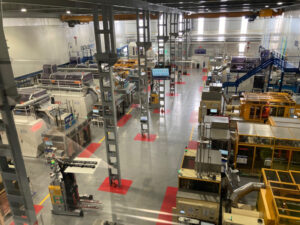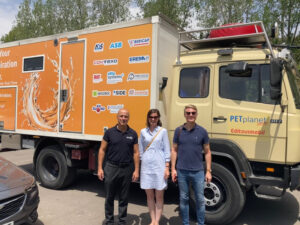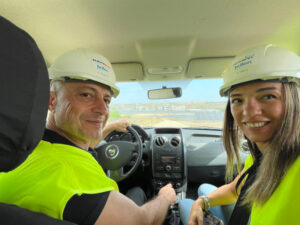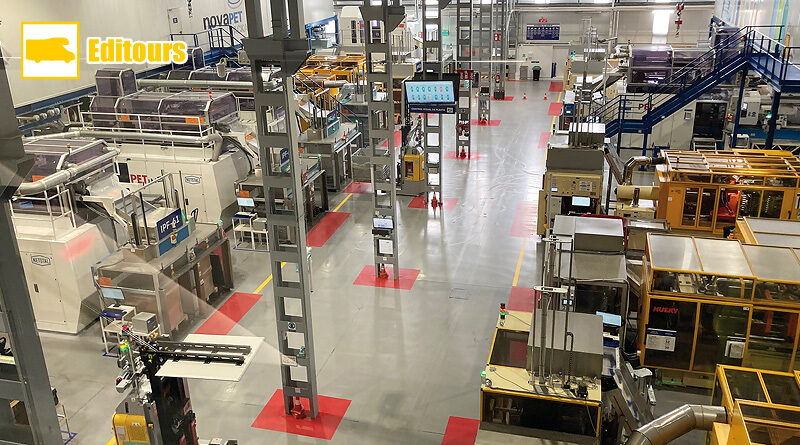Always in tune with the times
Spanish state-of-the-art PET packaging service
The next part of our Editour starts in the north-east of Spain. 230 km from Barcelona, heading northwest, the Editourmobile reaches the Spanish province of Huesca, which belongs to the autonomous community of Aragon. Our destination is the Comarca of Somontano de Barbastro, with the district capital of the same name, Barbastro. In this small town of about 17,000 inhabitants, the history of the place is as vivid as its corporate culture. The Novapet company plant is located in the south of the city. We are warmly welcomed by Ana Chéliz, Marketing Manager at Novapet, and David González, General Manager of Novapet.
When we enter the company premises, we cannot yet guess the dimensions of this impressive production site. In the air-conditioned office, a commodity not to be underestimated in the Spanish summer, David starts directly with some details: “Novapet was founded in 1996 and belongs to the Samca Group. It started with a production of 30,000 t of bottle grade PET resin per year. The polymerisation plant was expanded in two steps with TechnipFMC Zimmer + SSP from Polymetrix technology. Today, we have a capacity of 260,000 t PET resin per year. After successive expansions of our injection plant since 2016, we produce 75,000 t of preforms a year.” After these impressive figures, David continues: “We are always in close contact with the bottlers and can therefore react quickly to demand. We don’t just produce standard PET resins, our special motivation is the challenge, the special. We are market oriented, accomplished to manage packaging supply chain, in direct contact and together with fast-moving consumer goods producers,” he emphasises.

Production side
But enough of dry figures, Ana and David take us on a tour of the factory. As we put on our protective clothing and reach the entrance to the production hall, we pass a small showroom. Novapet produces more than 30 different types of PET resins. “We want to meet the needs of our customers and are in close and continuous contact during a project,” David adds. The company offers its customers rapid prototyping and pilot production, as well as special contracts to ease the price risk management. An important service in times like these.

In the anteroom of the production hall, we meet Carlos Álvarez, who is responsible for the management and control of the industrial injection moulding area. From a viewing platform, he proudly explains his machinery to us: in total we see 15 injection moulding machines.
On the right, the red lettering PET on a blue and white machine catches our eye. Here are five Netstal PET Lines plus nine Husky-HyPET machines with clamping forces from 3,500 to 6,000 kN. “We get our moulds from Husky, MHT and Otto Hofstetter. We work with moulds up to 96 cavities from 10 to 98 g. A wide range of configurations, wall thicknesses, colours or weights etc. are possible, of course this is based on the customer’s needs. We have maximum flexibility thanks to the interchangeability of the moulds and direct production monitoring with absolute process control in real time. One special feature is our software Shotscope, which is dedicated for monitoring and controlling the number of cycles and ensuring the performance of preventive maintenance. Our vision technology for quality defects at the preforms has a capacity of 27,000 pph. It is a real-time detection of any deviation from the established quality criteria,” Carlos finally explains and says goodbye at this point. We leave him to his machinery. We go outside in front of the production facility and after a short briefing by Ana we know what to expect next: the laboratory!
R&D and quality
Quality has a high priority at Novapet. Accordingly, there is a system that has grown since the company was founded, which adapts to new requirements and thus ensures quality. This integrated management system is called Lims. It includes ISOs for process quality, food safety, environmental and safety & health at work, as well as energy certification. The quality control of the produced resins and preforms takes place in the laboratory. Here we meet Olga, she explains that 15 people work in the lab 24 hours a day, 365 days a year. They test 11,000 samples per month. Their analysis service includes research, chemical and bacteriological analysis. The labor stuff examines the raw material, the end product and the environment.
To ensure the quality of the working processes, Novapet places particular emphasis on the training and long-term employment of its employees. Continuous training keeps operations personnel trained in the use of the latest technologies in the sector.
Recycled PET production
As we leave the lab, our gaze falls on a part of the factory site that still looks a little like a construction site. However, some installations can already be seen. David explains that the production of Novapet’s own rPET will take place on this part of the factory site. A 15,000 t/a plant is to be put on production by January 2023. However, due to demand, capacity expansion to double the volume is already being considered. The rPET produced will not be available for sale but will be used exclusively to produce own rPET products. “We use the Vacunite technology from Erema. The Austrian producer of plastic recycling machines combines its Vacurema bottle-to-bottle process with Polymetrix’s recently patented Vacuum Solid State Polycondensation (SSP). What makes this combination so special is that all steps of the thermal process take place in a nitrogen atmosphere. The result is unique quality rPET pellets that more than meets all the requirements for food contact.”

Sustainability and recent projects
After the explanation of this construction site, we visit another highlight on the Novapet site: We drive by an off-road vehicle from the lower production area to a hill and look down on a 25 ha area with a photovoltaic plant. “This is our self-consumption photovoltaic field project. As you see we have already started.”
From the hill we have also a look on the beautiful landscape around. From up here we can see a small stream meandering through the company grounds, as well as stork aeries on the factory buildings. “We try to support the storks, their aeries are very heavy, they weigh up to 500 kg,” David explains. “We live in harmony with nature here and try to reduce our environmental footprint through various partnerships and optimised transport routes, as well as at all points of our production. This starts with reducing the weight of the preforms, continues with an in-house biological wastewater treatment plant and continues with reducing emissions by shifting transport from trucks to rail. By switching transport alone, we were able to reduce CO2 emissions by 80%. And now we are expanding the photovoltaic system to use only our own produced green energy. Also, we do not create products that are not possible to be handled in a circular way,” David summarises.
The morning has passed quickly and the heat on the photovoltaic field finally drives us back indoors. We ask David one last question: Where do you see serious challenges today and where do you see Novapet in 10 years? “Despite all the difficulties we face in the packaging market, we have shown that PET-producing companies have a great capacity to respond to the market in complex or emergency situations and this gives us added credibility and confidence in our clients,” David affirms.
We thank Ana and David for their time, their patience, their conversations, and their willingness to provide information, and look forward to seeing them again soon – in Barbastro or at any other place where new, promising developments in the PET industry are being discussed.
Novapet is a local company with a strong packaging culture, placed close to the market and close to its customers, and offers multitude of different PET solutions. Novapet has around 200 customers worldwide. It is located in 30 countries on 4 continents. The company has a total turnover of 400 mill €. It is integrated into the conversion process, injection, blowing and finally into special and adapted projects. The company manufactures resins, preforms and blows bottles. The PET resins and concentrates are for: still and carbonated drinks, hot fill, stretching PET, glass-like looking PET bottles, matt-or shining metal look, ovenable trays, PET for direct injection, for different mono- and multilayer bottles, and a family of resins for extrusion/blowing bottles with and without handles. The preforms offer diverse types of mouths which cover the different needs of the current market. A second plant in Fuenlabrada near Madrid produces bottles for food and non-food products. Visit Novapet

